
………………………………………………………………………………………………………………………………………………………………………………………………………………………………………………………………………………………….
Firefighters were able to coax a dog to jump from the third story of a fiery apartment building on the evening of June 10. Stella squeezed through the balcony railings, jumped, and was caught by an Aurora, CO, police officer. She was take to a veterinary hospital for treatment of injuries and is expected to be okay. Sadly, there was a life lost during the blaze and several families have been displaced. Tragedies like this do happen, so the question becomes, how prepared are you for fires with your pet safety in mind?
In a 2014 article from PetMD, data resourcesd from the National Fire Protection Association shows that upwards of 500,000 pets a year are in some way, shape, or form, affected by house fires. Further, about 1,000 fires a year are directly related to having been started by pets.
The following are some safety tips, prevention tops and in the case of fire, from the article and are sure to offer some food for thought with regard to how safe both you and your pet are in your current living and work environments when it comes for fire.
Prevention is a Priority
- Extinguish open flames — Like moths drawn to light, pets tend to be curious about flames and will be attracted to candles, lanterns, stoves and open fires like the fireplace or BBQ. To avoid problems make sure all sources of fire are completely extinguished and do not pose a threat.
- Remove or protect stove knobs — Pets accidentally turning on stove knobs is the leading reason for pet started house fires, according to the National Fire Protection Association. Remove or protect stove knobs from activation while you are away.
- Flameless candles — Although not as aromatic as regular candles, the light bulbs in flameless candles are unlikely to start a fire if knocked over by your pet.
- Water bowls on wooden decks — Like starting a fire with a magnifying glass, the reflection of light through glass bowls can generate enough heat to ignite a wooden deck. Stainless steel or ceramic water dishes cannot focus light in the same way .
- Inspect and pet proof — Be alert to loose electrical wires, appliances, and other hazards within your pet’s reach.
Safety in Case of Fire
- Confine young pets — Puppies are notoriously curious and capable of finding trouble. Confining them to crates or pens while you are away will help reduce the risk of them causing a fire. The confined area should be near an entrance for easy access in case of fire.
- Keep pets near entrances — Firefighters can easily find and rescue pets that are near entrances. To ensure quick, safe transport, collars, leashes, and carriers should be near these same entrances. Have emergency kits with your pet’s medical information and a supply of medications that they regularly need close together. Know your pet’s safe hiding places and restrict access to them in your absence so they can’t flee there in fear and make it difficult for firefighters to find them.
- Monitored alert service — Battery operated smoke alarms will not only scare your pet but won’t alert anyone to a fire if you are not there. Monitored smoke detectors alert a monitoring system that can then alert both you and the nearest fire station.
- Pet Alert window clings — These static clings alert firefighters that pets are inside. Indicating the number of pets on these clings can help save critical time for firefighters. Free window clings are available online from the ASPCA or can be purchased at pet supply stores. They should be placed so they are readily seen by firefighters.
- Plan an escape route — Plan a safe escape route and have leashes and carriers easily accessible. Practice fire drills so your pet is familiar with the routine in case of fire. Pet friendly work places should also have a designated escape plan for workers and their pets. They also should perform routine fire drills so the plan is familiar to both workers and pets.
- Outdoor pets — Housing and pens for outside animals should be located clear of brush, bushes, or other vegetation that could act as fuel for a fire. Outdoor pets should wear or have implanted identification in case they flee your yard or property during a fire.
